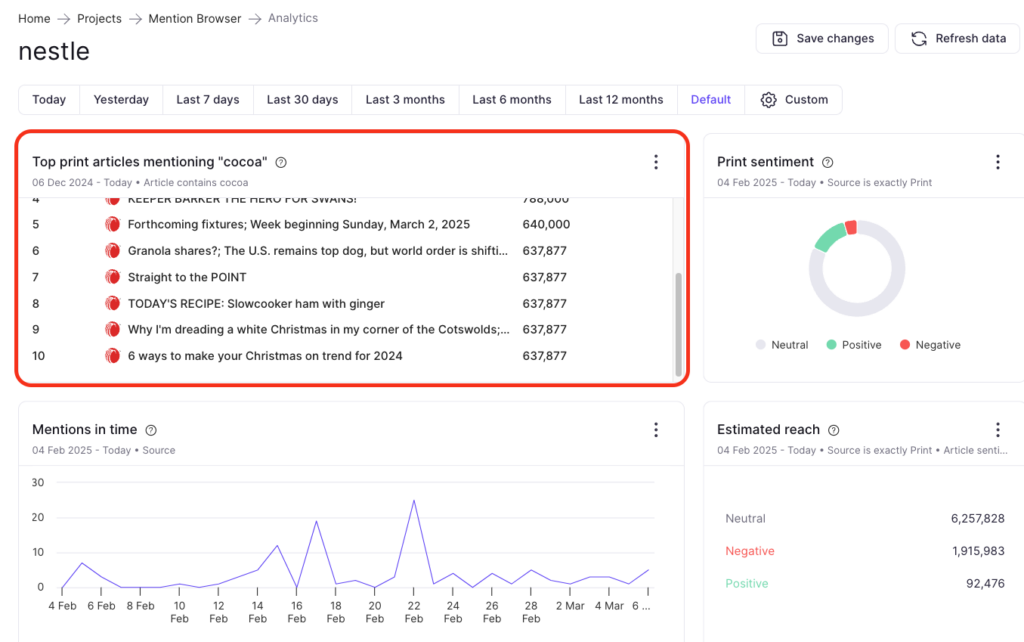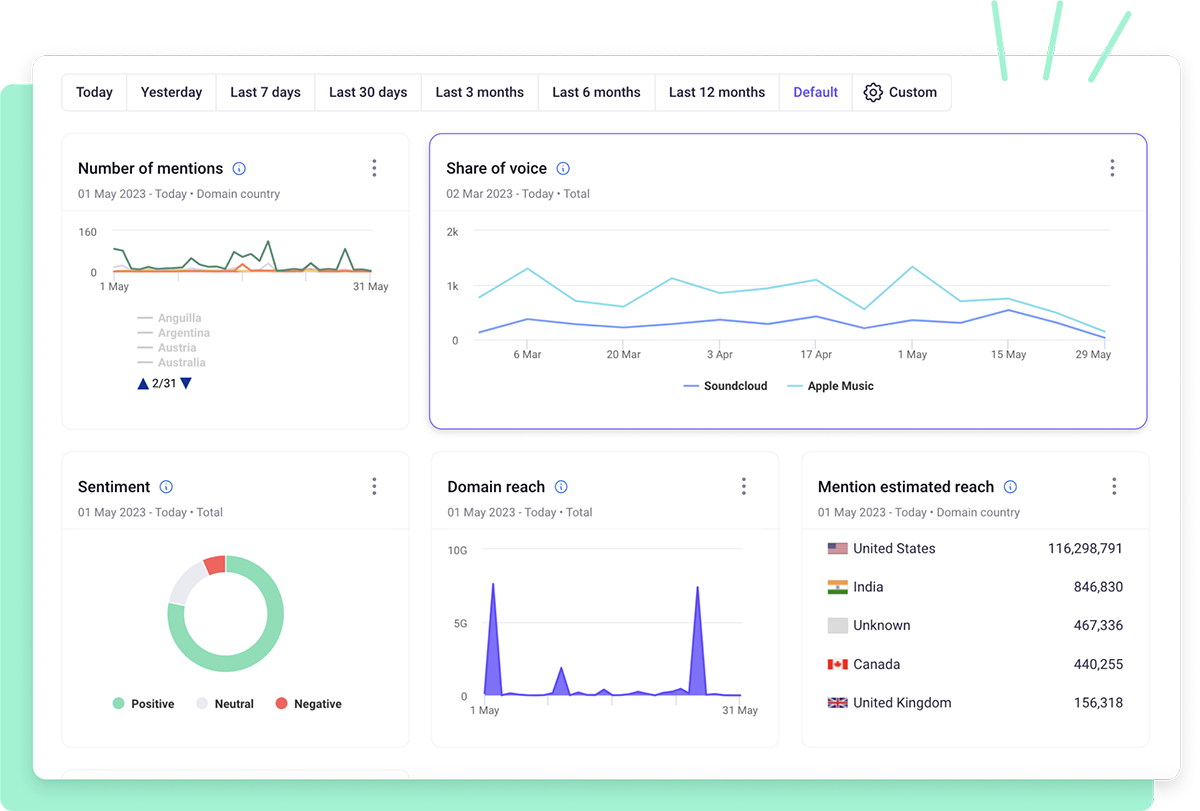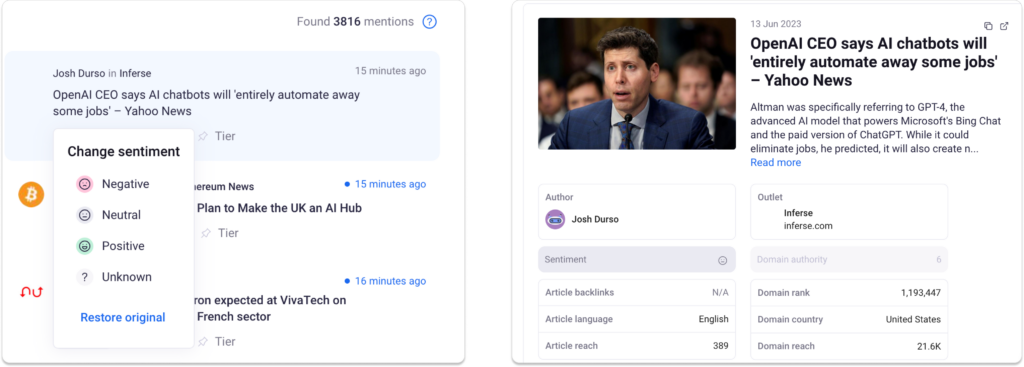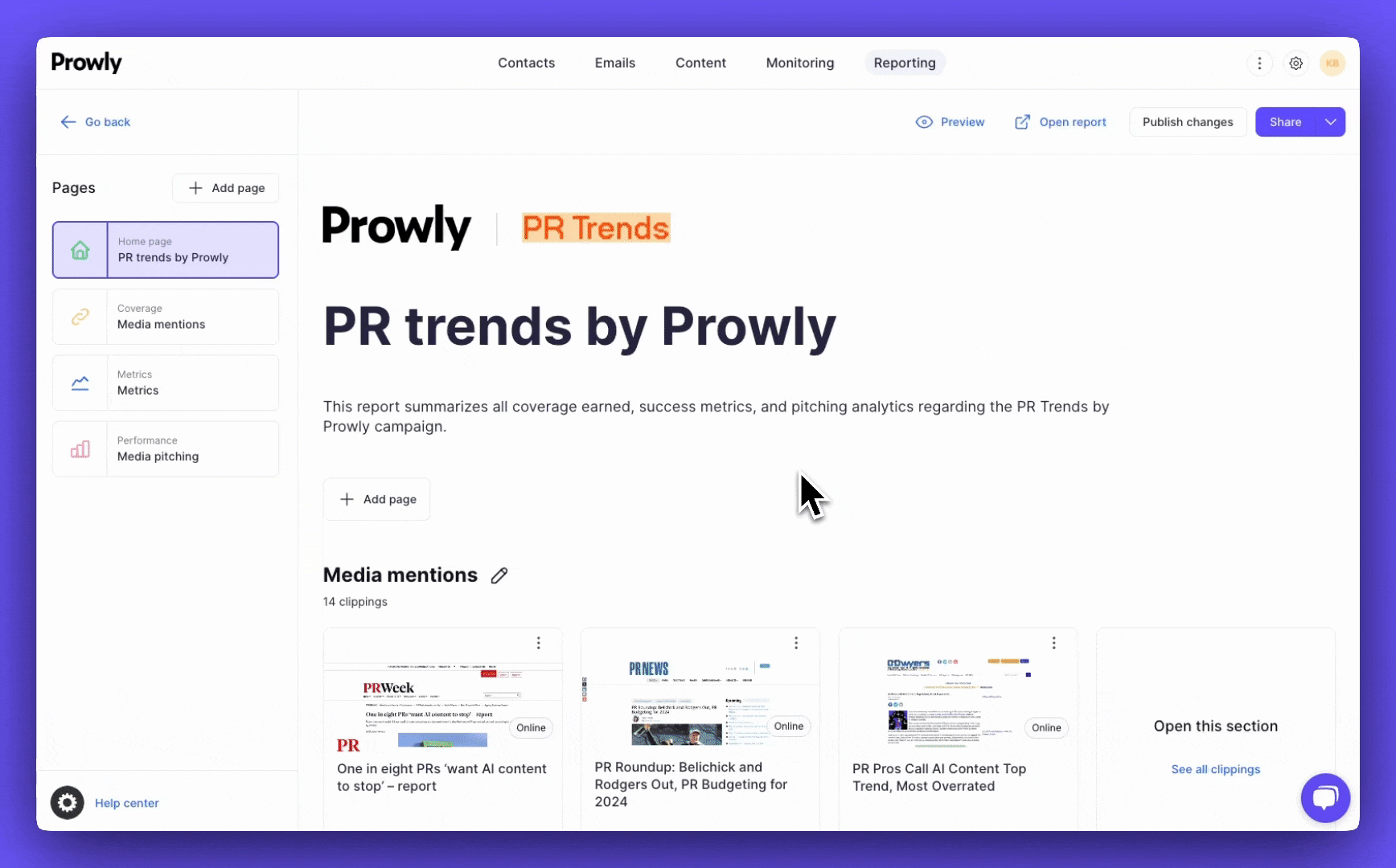Your public relations strategy shouldn’t just “feel” effective—it should prove its value. In today’s data-driven world, understanding how to measure PR ROI is essential to link PR campaigns to real business results.
PR ROI (Public Relations Return on Investment) shows how your public relations efforts are helping your business grow. You can measure it by looking at things like media mentions, website visitors, search engine rankings, and how much your brand stands out compared to others.
Tools like Prowly make it easy to track these results, link them to your goals, and share clear reports on how well your PR efforts are paying off.
This guide breaks down what PR ROI is, why it’s tricky to measure, and the specific metrics that help you show impact—not guess at it.
Try Prowly's media monitoring free for 7 days
Start tracking your brand and keywords for free (no credit card required) in Prowly.
- Comprehensive monitoring: Track the web, social media, print, and broadcast mentions
- Transparent pricing: Plans start at $258/month
- All-in-one platform: Get everything you need in one tool for PR, incl. media database, outreach, reporting, and more
What is PR ROI?
PR ROI, or return on investment in public relations, is about more than just money. It shows how your PR work helps build your brand’s reputation, increase awareness, and earn the trust of your audience.
While sales and revenue are important, PR ROI also includes these bigger-picture benefits that help your business grow over time.
Why is it so hard to measure PR ROI?
Measuring PR ROI may seem like a difficult task, but the path from your PR efforts to business results is often long and complex.
PR influences customers via multiple touchpoints over time. So there is no one specific action to follow and measure.
Many valuable outcomes may not be visible in a simple graph, but they make your brand shine none-the-less. Improved brand reputation, increased trust, and greater visibility are more intangible an don’t show clearly in traditional financial metrics. PR teams often also struggle with limited or inaccurate tools that can’t fully capture or connect these diverse impacts to concrete business goals.
If this sounds familiar, you’re not alone.
Fortunately, by setting clear objectives, using a mix of qualitative and quantitative metrics, and with the right tools, it’s possible to overcome these challenges.

💡 With Prowly, you can monitor all indicators that reflect how your brand is doing. Mentions, media monitoring (offline and online), and even create, distribute and track press releases. All of the data is collected and displayed in a comprehensive dashboard.
But to really understand the full impact of your PR efforts, it’s important to track the right things. PR influences many areas, from media mentions to online buzz, so focusing on a mix of raw numbers and their quality helps you see the full picture.
Here are the key things to measure to get a clear view of your PR ROI:
What to measure to track PR ROI metrics
PR influences many areas. So keep your fingers on the pulse to allocate your budget efficiently. You need to know what works and where.
#1 Website traffic and conversion
Check the number of people who visit your website through your PR stories. This shows whether your coverage is bringing in customers.
It also reflects how your brand resonates with your target.
#2 Media mentions and coverage
Follow the media who mentioned your brand. Verify their credibility and their volume of generated mentions. Plan outreach and responses, both in their feeds and in their emails, especially for those who pull a lot of weight in your industry.
#3 Share of Voice (SoV)
Use Share of Voice to see how much your brand is talked about compared to your competitors. Compare the coverage buzz your brand creates over time.

The bigger the share, the more control you have over your market.
#4 Social media reactions
Your social media presence is one thing, but engagement is another. Track likes, shares, comments, and other interactions with your PR content.
This indicates how well you know your audience and you can refine your strategies of reaching them.
#5 Sentiment and message impact
Pay attention to whether mentions are positive, negative or neutral and track if your key messages are coming through clearly.
Positive coverage that highlights your main points builds trust.

P.S. Want to dive deeper into sentiment analysis and how to use it to strengthen your PR? Check out these articles:
- How to Measure Brand Sentiment in PR - The 2025 Guide
- How to Use Sentiment Analysis in PR? The 2025 Guide
- 20+ Top Sentiment Analysis Tools for PR Pros - a 2025 List
#6 Skip AVE (Advertising Value Equivalent)
AVE tries to put a dollar value on PR by comparing it to ad costs, but it doesn’t show real impact and is considered outdated. There are a lot of other, more accurate indicators (like the above) that reflect your PR efforts more accurately.
Tools like Prowly make it simple to keep track of all these metrics in one place, helping you see how your PR efforts are paying off and making it easier to share your success. All the data is collected in one dashboard where you can analyse it, notice trends, tailor your strategy accordingly, and generate full PR reports.
#7 SEO signals (links and brand searches)
Look at the backlinks your PR generates and whether more people are actively searching for your brand online. Also, track what topics your brand is being associated with—there may be smart opportunities to boost visibility while staying aligned with your messaging and strategy.
Backlinks and branded search volume still play a role in visibility—but in the AI search era, PR-driven signals like brand mentions, trust, and media credibility are becoming even more influential.
SEO matters, but PR is now doing more of the heavy lifting when it comes to how your brand is surfaced, summarized, and recommended in AI-generated results.
Why brand mentions and trust are the new ROI drivers in 2025
As AI-powered search becomes more common, brand mentions and trust are starting to outweigh backlinks in shaping visibility.
Generative engines like ChatGPT and Google Search Generative Experience pull answers from sources they deem credible—not just those with the best SEO.
This means PR-led signals like earned media, sentiment, and consistent messaging now play a bigger role in how your brand is found and trusted.
Tools like Prowly help track those signals—so you can measure PR ROI not just by traffic, but by influence.
Prowly helps you track and grow the exact signals that influence your brand’s presence in generative search:
- Media mentions across top-tier and niche outlets
- Tone and sentiment of your coverage
- Share of Voice against competitors
- Clarity and consistency of your key messages
💡 With Prowly, you're not just tracking traditional PR metrics—you’re building the kind of visibility that AI trusts, ranks, and repeats.
This is why modern PR ROI must account for GEO. It’s no longer just about rankings—it’s about being recognized, cited, and trusted across the sources AI engines pull from.
5 PR metrics that matter most
#1 Media mentions and reach
What is it?
This tracks how many times your brand appears in the news, on blogs, or in other media. It also estimates how many people could have seen those mentions.
Why it matters:
More mentions and a wider reach means your brand is getting noticed, which builds awareness and credibility.
How to track it:
Platforms like Prowly can help you count mentions and estimate audience size for each placement. You can easily set up notifications about new mentions and follow them in real time.
#2 Website traffic and conversions
What is it?
The number of visitors to your website that came from your PR materials in media coverage.
Why it matters:
If people are clicking on your site, it shows your PR is sparking real interest and driving potential customers to learn more.
How to track it:
Use Google Analytics to monitor referral traffic and set up UTMs to see traffic sources.
#3 Share of Voice
What is it?
Share of voice compares how much your brand is talked about in the media compared to your competitors.
Why it matters:
A big share means you are a big player in your niche and allows you to share details over your growth over time.
How to track it:
Media monitoring tools like Prowly can help you see how your coverage stacks up against the competition.
#4 Social media engagement
What is it?
Engagement means likes, shares, comments, and all interactions on social media posts that result from your PR coverage.
Why it matters:
High engagement means your PR stories touch your audience's interests. In other words, they work.
How to track it:
Social media dashboards like Sprout Social make it easy to follow engagement numbers. You can also monitor it manually.
#5 Sentiment and messaging clarity
What is it?
Sentiment analysis checks if your main messages are being communicated and received, and whether your media coverage is positive, neutral or negative.
Why it matters:
Positive coverage and clear messaging help build trust and reinforce your brand’s reputation. If negative mentions arise in numbers, it should be your red flag to react and take some preventive steps to avoid a brewing crisis.
How to track it:
Tools like Prowly analyze sentiment and show if your key messages are being picked up. You can be notified about negative sentiment spikes and monitor active cases to react quickly.
How to calculate PR ROI (a simple formula)
To calculate ROI, use this formula:
PR ROI = (Value of PR Outcomes – PR Costs) / PR Costs
Example:
You spend $2,000 on a PR campaign that brings you $12,000 in measurable value (leads, sales, coverage).
ROI = ($12,000 – $2,000) / $2,000 * 100 = 500%
This means every $1 you invested brought you $5 more.
How to connect PR to business goals? Framework to follow
| Goal Type | Example | Metric to Track |
| Awareness | Get media buzz on launch | Media coverage, SOV |
| Consideration | Drive site traffic | Referral traffic, bounce |
| Conversion | Convert leads | SEO goals, lead gen |
Linking your PR efforts to business goals is not a piece of cake, but with this framework, it can go more smoothly.
👉 First, define which of the above goals is closer to your needs: raising awareness, encouraging people to learn more, or driving sales.
👉 Then, choose the specific metrics that align with each goal.
This way, you can clearly demonstrate how your PR activities contribute to your company’s success and thus make it easier to track progress and optimize your strategy accordingly. Keep monitoring and tailor it to the shifting market as you go.
What tools help track and report PR ROI?
| Function | Tools | What They Do |
|---|---|---|
| Monitoring | Prowly, Brand24 | Track media mentions, monitor brand coverage, and analyze sentiment in real time |
| Analytics | Google Analytics 4 (GA4), Looker Studio | Measure website traffic, track user behavior, and create custom dashboards for PR impact |
| SEO Impact | Ahrefs, Semrush | Analyze backlinks, keyword rankings, and branded search trends influenced by PR |
| CRM & Lead Attribution | HubSpot, Salesforce | Connect PR activities to lead generation and sales, and track customer journeys |
| All-in-One PR Platforms | Prowly | All-in-one PR platform for media monitoring, CRM, and reporting—plus tools to track and optimize the trust signals that influence AI search visibility. |
Combine monitoring, analytics, SEO, and lead-related activities. This way you can cover all the bases and create a multichannel strategy. Thus, your efforts will have even greater impact and your ROI will improve. Prowly connects all these in one intuitive, ready-to-share dashboard.
How to report PR ROI to stakeholders
Measuring PR ROI matters most to stakeholders.
When sharing PR results with stakeholders, keep things simple and focus on impact, not just activities. Instead of listing how many press releases you sent or mentions you got, show how these efforts helped the business, like in boosting brand awareness, increasing website visits, or generating leads.

Use easy-to-understand visuals like charts and graphs to keep them interested. It’s also helpful to show progress over time, so present how it was and how it has changed. Speak in plain language that connects PR results to business goals, drop complicated terms and industry jargon.
To make reporting even easier, tools like Prowly offer features that help you create clear, visual reports that tell the story of your PR success in a way everyone can understand.
FAQ: Your top PR ROI questions and answers
What does PR ROI really mean?
PR ROI is the measurable return you get from public relations, including visibility, traffic, and brand equity.
What are key PR metrics?
Media coverage, web traffic, backlinks, sentiment, and share of voice.
Is PR ROI tied to revenue?
Yes, especially when using analytics and CRM tracking tools to link earned media to lead gen and conversions.
What’s better than AVE?
Actual impact metrics like traffic, backlinks, and quality media placements which can be tracked through platforms like Prowly.
PR ROI - summing up
Smarter PR means making your efforts measurable and data-driven. What once felt intangible, like brand reputation or trust, can now be tracked and quantified with the right numbers in hand.
Today, PR is no longer just about stories and your image; it’s a discipline grounded in clear metrics and real business impact. With modern tools and strategies, you can easily show the impact of your work value.
Does your PR really matter?
With Prowly, it’s easy to keep tabs on media coverage, build reports, and show the real impact of your work. Whether you're getting your name out there or bringing in leads, your PR should speak for itself and shine.
